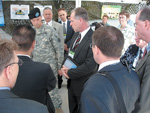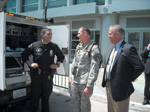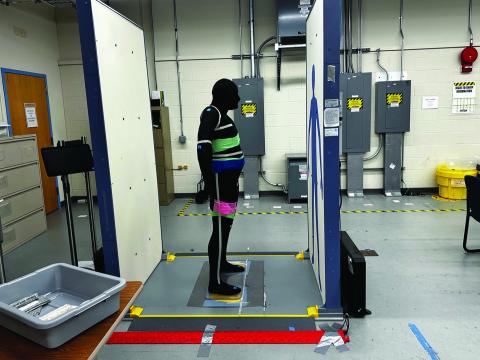Military Aligns Disaster Response Across Country
 |
During the Defense Information Systems Agency (DISA) Customer Partnership Conference in April, DISA Director Lt. Gen. Carroll F. Pollett, USA (3rd from l), and others are briefed on the engineering aspects of the agency’s ability to uplink tactical radios quickly with satellite communications in a field environment. |
The Defense Information Systems Agency is stepping up its outreach to homeland security partners in all tiers of government in another Defense Department effort to improve interoperability. Plans include building personal relationships and improving technical knowledge as personnel from the agency attend increasing numbers of events across the nation. The agency also is pursuing more formal synchronizations through high-level channels. Officials believe the work will result in better, more coordinated responses to catastrophes. The work often places the federal agency in a consultant role, advising others on best practices and new ideas for purchases and procedures.
The Transformational Communications Engineering branch of the Satellite and Wireless Engineering Division of the Global Information Grid (GIG)
Tracy Allison, chief of GE223 Transformational Communications Engineering, says that through events, DISA personnel meet people and build relationships that come in handy during actual emergencies. As part of the interactions, DISA fills an advisory role in which it makes suggestions on what state, local and even other federal partners could do to better interoperate with the military. “It’s good for both sides,” Allison says. DISA leverages its knowledge and expertise on technical issues for occurrences that are characterized by a lot of chaos such as a natural disaster. The military encounters the same situations in war zones.
The defense agency often has a lead on technical capabilities and through outreach can demonstrate these to other organizations. Allison and his colleagues are trying to increase the frequency and amount of collaboration by making it a point to contact local agencies when they attend an event, as well as by participating in other conferences and exercises as a matter of process. An example of reaching out to new partners took place at the DISA Customer Partnership Conference in
The police force was unaware of certain capabilities and reevaluated some of its equipment procurement plans based on what DISA showcased. If the military is called in to assist with an emergency in the
The J-6 of U.S. Special Operations Command (SOCOM), Col. Chris Argo,
Allison’s office also has ongoing follow-on activities with the DHS, U.S Northern Command (NORTHCOM) and other organizations with a series of collaborative events probably to include the DISA Customer Partnership Conference 2010. In addition, “We hope to engage in further activities with LAPD and other local emergency response organizations in the future,” he shares.
Because DISA often has more advanced communications than local and state agencies, such as better satellite communications systems, it can demonstrate to others available advantages. However, the goal of the exchanges is to facilitate disparate organizations’ cooperation. Jones explains that the modus operandi is, “Let’s work with each other. You show us your stuff; we’ll show you our stuff, and let’s interconnect the two.” Sometimes, the partners have the opportunity to test their strategies earlier than expected. When Hurricane Katrina hit the U.S. Gulf Coast in 2005, DISA was participating in the annual Defense Department Joint Users Interoperability Communications Exercise (JUICE). When the disaster struck, knowledge and partnerships developed partly through JUICE and other communications exercises were leveraged to help support the mission.
Jones’ office was involved in JUICE that year with some on-site work but mostly through remote work as technology facilitators and problem solvers. Some aspects supporting JUICE were reallocated to response efforts following hurricanes Katrina, Rita and Wilma. DISA also participated in this year’s JUICE in June. That event, as Jones describes it, is “sort of a coalition of the willing. It’s let’s work together and collaborate, and we’ll end up with a system that serves everyone.”
John Caruso, chief of the Executive Agent for Theater Joint Tactical Networks Office—a key responsibility of which is to support JUICE—says DISA and the communications exercise search for gaps in communications, command and control, and network operations. He emphasizes the importance of having all the equipment on the ground with all the other equipment to open up everyone’s eyes to what will work. DHS personnel play a role in JUICE, furthering efforts to coordinate military and homeland security resources.
JUICE coordinates with local levels as well. In
 |
Officer Paul Ricchiazzi (l), Los Angeles Police Department (LAPD) Emergency Operations Division; an unidentified U.S. Army colonel (c) from the U.S. Special Operations Command; and Tracy Allison, chief, GE223 Transformational Communications Engineering, DISA, interact during the DISA Customer Partnership Conference. Agency officials are working to forge relationships with personnel at other organizations who must work together during disasters. |
Also during the
The operative word in all the efforts is rehearsal, according to Jones, and he adds that a related aspect is establishing points of contact in various organizations. When personnel from separate entities cooperate in an exercise, they are more prepared for a disaster and know who possesses what capabilities in response efforts. The military builds networks and infrastructure behind troops while local levels essentially need telephone, radio and Internet capabilities. The military also has to encrypt more communications and has heavier equipment. Advance rehearsal makes transitions from first responders to those who follow easier than if organizations operate in a vacuum, Jones explains. Industry also plays a role in the efforts, providing equipment and personnel.
Though GE223 Transformational Communications Engineering has participated in military exercises and customer conferences for years, Allison says his office now intends to be involved in all Defense Department interoperability demonstrations to make sure DISA has a presence at every one of those events. One reason for the busy schedule is to remain abreast of current happenings. Another is to fatten the Rolodex of homeland security contacts that make the difference when the military has to respond to a domestic community problem.
Jones adds that through the collaboration changes come about such as effects on the equipment organizations procure. He continues that the directorate is trying to make many of these changes informally by demonstrating technology and remembering names and faces. “Informal partnerships and collaboration on events, such as the DISA Customer Conference and JUICE, help leverage upon relationships and increase collective knowledge and help make appropriate decisions on technology utilization for DOD and non-DOD [such as DHS],” Jones says.
Casual as certain relationships may be now, they could lead to something more serious in the future. Allison explains that as his group talks with NORTHCOM and local responders, a question has arisen: “Would there be a need or desire to have some sort of consultancy on the part of DISA in collaboration with NORTHCOM and FEMA, so when a police department or fire department wants to go out and do an equipment purchase, it can submit its plans to this consultant group who would just give it a once-over?” The group could make sure that local and state units have certain capabilities for various situations. No such service exists now, and DISA is studying its feasibility.
Allison states that such a group would not result in DISA telling other organizations what to procure, but rather it would lend the agency’s opinion and knowledge to interested parties. “They might not realize there are certain things out there like an interface to connect to NORTHCOM and FEMA,” he explains. DISA might know about methods to connect cables that would minimize equipment personnel have to wear. Another example of knowledge DISA can share is working land mobile radios into Defense Department-survivable cellular phone systems.
DISA demonstrated that technology during its interchange with the LAPD. Allison says the police department was unaware that the military had the capability to take a land mobile radio, patch it through a Defense Department gateway and access plain old telephone service through the radio. Such revelation, he adds, is not unique to the LAPD and could apply to various organizations, providing useful capabilities in emergency situations where telephone lines are not functioning. The goal is to establish connectivity back to individual first responders and to do it in such a way that they are tied into other elements of homeland security and homeland defense.
In all its informal outreach efforts, DISA cannot guarantee anyone will follow recommendations. “It’s like a word to the wise,” Allison says. The agency does not dictate policies to others, but it wants to help them make better decisions. He explains that the outreach is not DISA trying to get involved in everyone’s business. The agency has no profit and no stake in the decisions; it purely wants to show military capabilities and what would make systems work better with others.
Allison continues that his team’s job is to improve military technology interoperation with the equipment others have and make recommendations for future improvements. “If we had Hurricane Katrina today, we could respond much better than we did then,” Allison shares. All departments and budgets never will synchronize, but stakeholders can agree to exhibit what they have and strive to make those capabilities work. Though DISA would like the efforts to help increase cooperation among state and local units, the focus is on NORTHCOM-provided equipment that would show up in any state during an emergency. By default, FEMA and NORTHCOM talk to one another any time there is a major event to which the military responds. And though local units need telephone, Internet, voice and data just as the military does, the systems may not be interoperable.
In parallel with the bottom-up approach DISA is taking to improve interoperability, the agency also has the top-down method. “We’re reaching out to all levels,” Allison says. DISA is pushing technologies and capabilities through official military channels to provide equipment to organizations such as the National Guard so it understands new capabilities are coming down the road. That push does not reach the local level unless some of it trickles down through FEMA. GE223 Transformational Communications Engineering is trying to integrate the two sides, but, Allison says, integration will not occur quickly enough if top-down is the only method of approach.
The outreach efforts by Allison and Jones have not yet involved federal law enforcement such as the Federal Bureau of Investigation (FBI) or
WEB RESOURCES
Norman Jones’ e-mail: njones@aaski.com
Global Information Grid
Los Angeles Police Department: www.lapdonline.org
Executive Agent for Theater Joint Tactical Networks: www.sec.army.mil/secweb/value_added/ea_tjtn_vas.php




Comments